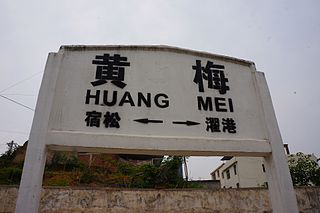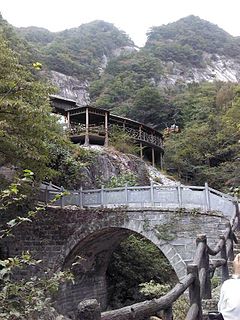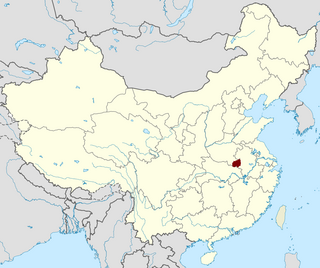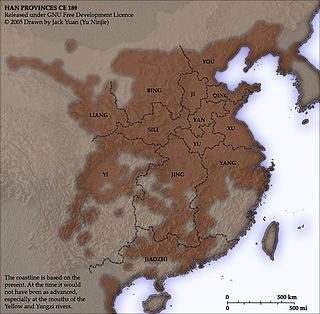
Huangmei County falls under the administration of Huanggang City in eastern Hubei province, People's Republic of China, and borders Anhui to the east and Jiangxi to the south across the Yangtze. It also administers Shanjia Islet (单家洲) in the Yangzte.

Hong'an County, formerly named Huang'an County, located to the north of Wuhan, is a county in Huanggang, Hubei province, People's Republic of China.

Luotian County is located in the northeast of Hubei province, China and it is under the administration of Huanggang City. The county is on the south side of the Dabie Mountains with the highest peak, Tiantangzhai, situated in the northeastern part of the county. Luotian county covers an area of 2,144 square kilometres (828 sq mi) and had a population of about 600,000 in 2016. The Dabie Mountains attract thousands of tourists from all over the province every year and the most popular tourist sites include Tiantangzhai National Forest Park, Bodaofeng National Forest Park, and Sanlifan Hot Spring.
Huang Chao was a Chinese smuggler, soldier, and rebel, and is most well known for being the leader of a major rebellion that severely weakened the Tang dynasty.

Dongpo pork is a Hangzhou dish which is made by pan-frying and then red cooking pork belly. The pork is cut thick, about two inches square, and should consist equally of fat and lean meat. The skin is left on. The mouthfeel is oily but not greasy and the dish is fragrant with wine. The dish is named after the Song Dynasty poet and gastronome Su Dongpo.
Nanhu may refer to the following in mainland China or Taiwan:

Huanggang Normal University is a full-time provincial public normal university in Huangzhou District, Huanggang, Hubei, China. It is under the Educational Administration of Hubei Province. HNU offers courses to undergraduate students as well as other training courses for continuing education.

Huangpi District is one of 13 districts of Wuhan, the capital of Hubei province, People's Republic of China, situated on the northern (left) bank of the Yangtze River. The Sheshui enters the Yangtze at Huangpi. The district is primarily rural, but also includes important infrastructure facilities, such as Wuhan Tianhe International Airport and Wuhan North Railway Station, which is one of the main freight stations and marshalling yards on the Beijing–Guangzhou Railway. It is the northernmost of Wuhan's districts as well as the most spacious. On the left bank of the Yangtze, it borders the districts of Xinzhou to the east, and Jiang'an to the south, and Dongxihu to the southwest; on the opposite bank, it borders Hongshan. It also borders the prefecture-level cities of Huanggang to the northeast and Xiaogan to the northwest. The Sheshui enters the Yangtze River at Shekou in Huangpi.

Wang Xianzhi was a major agrarian rebel during the reign of Emperor Xizong of Tang, whose rebellion, while failing, along with those of his one-time ally Huang Chao, began a series of rebellions that led to Tang Dynasty's disintegration.
Lukou may refer to the following locations in China:
Zouma is the name of several people:

The Ehuang Yangtze River Bridge crosses the Yangtze River in Hubei, China. The bridge carries traffic on China National Highway 106 between Echeng, Ezhou south of the river and Huangzhou, Huanggang to the north. Construction of the bridge started in 1999 and it was completed in 2002. The bridge is 1,290 m (4,230 ft) long and has a main span of 480 m (1,570 ft) placing it among the longest cable-stayed bridges in the world.
Anzhou or An Prefecture was a zhou (prefecture) in imperial China, centering on modern Anlu, Hubei, China. It existed (intermittently) from 550 until 1119, when the Song dynasty renamed it De'an Prefecture.

Guang Prefecture was a prefecture of imperial China centered on modern Huangchuan County, Henan. It was created in the 6th century under the Liang dynasty and existed intermittently until 1913, after the establishment of the Republic.
Guizhou or Gui Prefecture (歸州) was a zhou (prefecture) in imperial China centering on modern Zigui County, Hubei, China. In the Yuan dynasty it was briefly called Guizhou Military Commission (歸州安撫司) and Guizhou Route (歸州路). It existed (intermittently) from 619 until 1912.
Xiázhou or Xiá Prefecture was a zhou (prefecture) in imperial China centering on modern Yichang, Hubei, China. It existed (intermittently) from the 6th century to 1376.

Xian was a minor state of the Western Zhou and Spring and Autumn periods, whose capital was located at modern-day Qishui, Huangzhou District. While it controlled only a small territory along the Yangtze, the Wei clan (隗) that ruled Xian maintained far-reaching diplomatic and marital relations with many neighboring states.



















